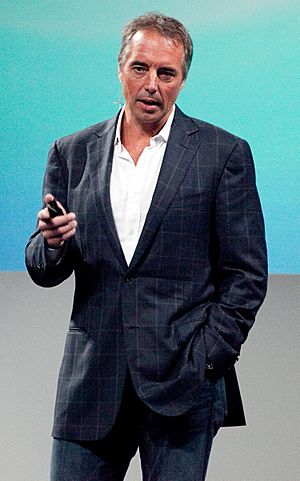Dan Buettner facts for kids
Quick facts for kids
Dan Buettner
|
|
|---|---|

Buettner in October 2010
|
|
| Born | June 18, 1960 |
| Nationality | American |
| Occupation | |
Dan Buettner (born June 18, 1960) is an American explorer, author, and public speaker. He is known for his work on "Blue Zones." These are special places where people live much longer and healthier lives.
Dan Buettner also helped create a TV show called Live to 100: Secrets of the Blue Zones. This show came out in 2023 and won three Emmy Awards. He also holds three Guinness World Records for long-distance cycling!
Contents
About Dan Buettner
Dan Buettner was born in Saint Paul, Minnesota, on June 18, 1960. He studied Spanish and Literature at the University of St. Thomas. He finished his degree in 1983.
After college, he worked for a newspaper columnist. Later, he joined National Public Radio. There, he helped organize a special event with famous people.
Dan's Amazing Bike Journeys
In 1986, Dan Buettner started setting Guinness World Records. He cycled across continents! His first big trip, "Americastrek," covered 15,536 miles (25,000 km). He rode from Alaska all the way to Argentina.
In 1990, he and his brother Steve went on "Sovietrek." They cycled 12,888 miles (20,741 km) around the world. In 1992, the brothers went on "Africatrek." They rode 11,885 miles (19,127 km) across Africa. This journey took eight months.
Exploring Long Life: The Blue Zones
Dan Buettner noticed that many adults were interested in his adventures. He then had an idea to research places where people live a very long time. He shared this idea with National Geographic, and they supported him.
He worked with scientists to find these special places. He even received a grant to help with his research. Before his work, some long-life spots were already known. These included Sardinia, Okinawa, and Loma Linda.
Discovering Longevity Hotspots
Starting in 2003, Buettner led trips to these areas. He worked with many experts, like anthropologists and dietitians. His first trips focused on Sardinia, Italy; Okinawa, Japan; and Loma Linda, California.
In 2005, he wrote a cover story for National Geographic Magazine. It was called "Secrets of Long Life." This article shared his findings about communities with many long-living people. These places became known as "Blue Zones."
In 2006, he found a fourth Blue Zone in Costa Rica. He worked with a demographer named Dr. Luis Rosero-Bixby. In 2008, he found a fifth Blue Zone on the Greek island of Ikaria.
Sharing the Blue Zones Secrets
In April 2008, Dan Buettner released his book, The Blue Zones: Lessons for Living Longer From the People Who've Lived the Longest. This book shared all his discoveries. It led to many interviews on popular TV shows.
In 2010, he published Thrive: Finding Happiness the Blue Zones Way. This book looked at the happiest places on Earth. He believes that true happiness comes from a healthy environment.
In 2015, he released The Blue Zones Solution: Eating and Living Like the World's Healthiest People. This book listed the top places for long life. It became a New York Times Best Seller.
In 2019, Buettner and a National Geographic photographer revisited the Blue Zones. They studied the diets of people living there. This research led to their book, The Blue Zones Kitchen.
What Are Blue Zones?
The idea of "Blue Zones" was first developed by Michel Poulain. He is an expert in how long people live. He identified five of these special areas. Dan Buettner became very interested in this discovery.
By 2003, Buettner created a company called Blue Zones®. In 2020, another company, Adventist Health, bought Blue Zones® LLC.
Making Communities Healthier: Blue Zones Projects
In 2008, Dan Buettner wanted to apply his Blue Zones ideas to a town in America. He chose Albert Lea, Minnesota, for the AARP/Blue Zones Vitality Project. He believed that making the environment healthier was key.
The results in Albert Lea were amazing! The community started walking and biking 80% more. City workers' healthcare costs went down by 49%. Smoking also decreased by 4%. The town lost 12,000 pounds and added three years to their average life expectancy.
In 2010, Buettner partnered with Healthways to expand this work. They started Blue Zones Projects in other cities. In Southern California, three communities saw great improvements. People's BMI (a measure of body fat) went down by 14%. Smoking dropped by 30%. Healthy eating and exercise increased.
Since 2011, the Blue Zones Project has worked in many places. This includes 18 cities in Iowa, and projects in Texas and Hawaii. In 2014, work began in Florida, Indiana, and Oregon. In 2018, Klamath Falls, Oregon, won an award for being a "Culture of Health" community.
Dan Buettner's TV Series
In 2023, Dan Buettner helped create and appeared in a TV mini-series. It was called Live to 100: Secrets of the Blue Zones. This show explores the secrets of living a long and healthy life.
Public Speaking Engagements
Dan Buettner often shares his knowledge with others. He has spoken at important events like Bill Clinton's Global Initiative in 2013. He also gave a popular TED Talk in 2009. His talk, "How to live to be 100+," has been viewed over 4.7 million times!
Dan's Personal Habits
Dan Buettner follows a healthy lifestyle himself. He describes his own diet as "98% plant-based." This means he mostly eats foods that come from plants.

